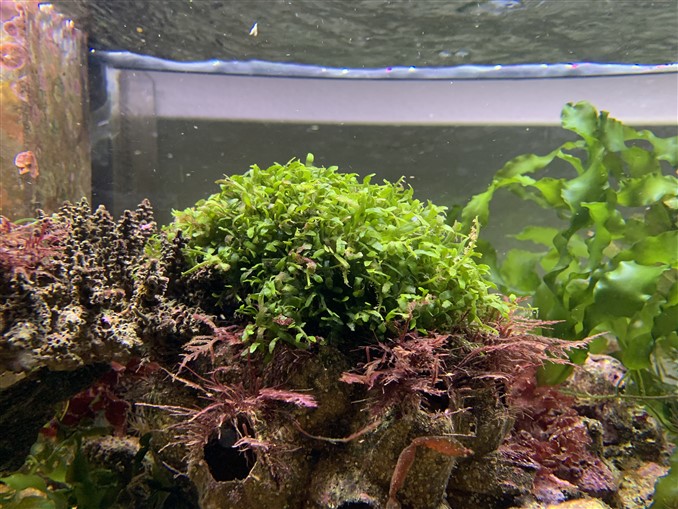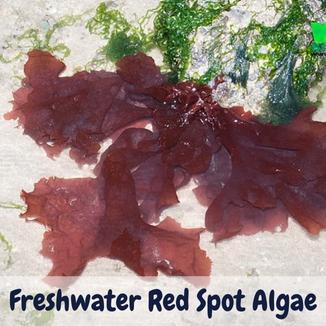Rhodophyta is the scientific name for the multicellular organism known as red spot algae freshwater. It may overgrow in any aquarium.
If not treated promptly, this infection will spread widely and affect your fish’s health. Don’t get yourself stressed too much!
This post will explain the causes and also recommend solutions to solve this issue. Let’s dig into it!
Contents
Red Spot Algae: Common Causes
You may be curious to know what type of issue causes red spot algae to increase in your tank.
You can protect your aquarium against their invasion by learning everything there is to know about these uncommon and unusual freshwater Rhodophyta.
Knowing what approach you should take if your tank becomes infected is also beneficial.
Here are several reasons why these algae grow in your aquarium, according to information from a variety of sources:
Introducing New Species
It’s the plausible explanation for why adding additional plants or water polluted with them from the other containers allowed the red spot algae to flourish.
Unseen little filaments may attach to newly introduced aquatic species in water and give rise to fresh spores in your new tank.
These organisms may grow after they are placed in a suitable tank environment.
Unstable Nutrients
Almost all species of Rhodophyta are always triggered to emerge by unstable macronutrients.
The emergence of red spot algae is frequently linked to higher environmental nitrate and iron concentration.
Some aquarists thought using dirt beneath the substrate was the thing that might make it grow.
[display-posts id=”3213″ image_size=”thumbnail” posts_per_page=”1″]
Excessive Heat And Co2 Deficiency
In their natural habitat, these organisms may usually be seen in streams with clear water, consistent nutrients, little CO2, and high temperatures.
These conditions may encourage Rhodophyta growth in your aquarium when it has these favorable conditions.
Excessive Lighting Intensity And Spectrum
These Rhodophytas will have a chance to flourish in your tank if there is too much illumination intensity and spectrum and not enough native organisms to absorb the extra light.

Are Red Spot Algae Freshwater Dangerous For Fish?
When detecting these organisms in your tank, you may wonder: Will red algae hurt my fish?
In reality, these organisms pose little threat to fish or other animals, like most Rhodophyta that frequently attack planted aquariums.
They become an additional snack in spare time for a few fish and shrimp species.
If your aquarium begins to look dreadfully red, on the other hand, you certainly do not want them.
Your plants may perish if you leave these organisms in your tank because they will take in all the nutrients of the vegetation.
[display-posts id=”4699″ image_size=”thumbnail” posts_per_page=”1″]
How To Get Rid Of Red Spot Algae Freshwater In Your Tank?
How do you get rid of red algae? You may use the following strategies to control and minimize Rhodophyta in an aquarium.
Introduce Algae Eaters
When tank owners become aware of an algae problem, they sometimes buy algae-eating species as their initial course of action.
What animal eats red algae? The most common type is Plecostomus. They are exceptionally enormous for most aquariums.
Another species you could consider is the Chinese Algae Eater, but they may turn aggressive as they age.
Additionally, the small Otocinclus is an excellent option. Although tiny, they will attack the Rhodophyta when you introduce them to your aquarium.
Other creatures, such as Apple Snails, will consume some Rhodophyta, but they might severely damage any living vegetation in your tank.
If you want to learn more about Apple Snails before adding them to your tank, it’s better to check this video first:
https://www.youtube.com/watch?v=vAyrkZu4bCk
Avoid Overfeeding Your Fish
Don’t feed your pets excess food that floats to the substrate of your tank. Instead, learn to estimate how much they will consume in minutes.
Consider placing them on a routine of feedings or diets where they skip meals daily or more each week.
Fish are tough to starve, and by reducing trash in their aquarium, you are giving them a better habitat to live in.
[display-posts id=”3788″ image_size=”thumbnail” posts_per_page=”1″]
Change Water Regularly
An excellent practice to establish is changing the water weekly by around 30 percent and sanitizing it more thoroughly once a month.
All tanks build up toxic waste substances, and by changing some freshwaters once weekly, you may reduce the pollution.

Change water regularly
[display-posts id=”3142″ image_size=”thumbnail” posts_per_page=”1″]
Turn Off The Lights
Controlling the duration of light exposure is a fantastic strategy to prevent Rhodophyta formation in plastic plants.
Keep in mind that these organisms produce their nutrition through photosynthesis. They can’t grow as quickly if you turn off some lights.
[display-posts id=”3367″ image_size=”thumbnail” posts_per_page=”1″]
Avoid Direct Sunlight
Place your tank where it can’t obtain direct sunlight during the day. With enough sunshine, Rhodophyta will proliferate. Additionally, direct sunlight is not ideal for your pets.
The intense light and higher aquarium temperatures may put them under too much stress, which might harm their health.
Add Live Plants
When reducing the growth of these organisms, adding green plants to a tank may make a big difference.
Fish excrement is beneficial for growing living plants but detrimental to preventing the formation of algae.
Rhodophyta will suffer since healthy plants are better able to absorb nutrients.
Utilize Distilled Water
These organisms commonly develop due to the high iron or metals typically present in tap water.
Utilize distilled water instead of that water that would otherwise be wasted while changing the water in your tank.
Check The Water Circulation
Some species of algae grow in the aquarium’s dead spots, which are locations with poor water movement.
Pick the proper tools so you can enhance the water volumes by adding a tiny powerhead.

Check the water circulation
Apply Chemical Controls
Using algaecides could be the final resort when you feel like giving up.
It is commonly known that Rhodophyta control chemicals effectively eradicate these algae in aquariums.
Yet, they can also harm some plants, so it’s best to take the medication carefully.
The efficacy of the treatment will be better by regular water changes before administering the medications.
Wrapping Up
The red spot algae freshwater will appear in your aquarium due to various causes like introducing new plants or fish, unstable nutrients, or excessive heat.
Although these organisms may not harm your pets, it’s better to take action before the case worsens because prevention is better than cure.
You will be successful with our recommendations. Let’s try one of them to save your tank. Thanks for reading!

